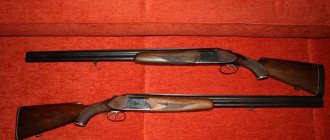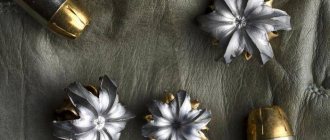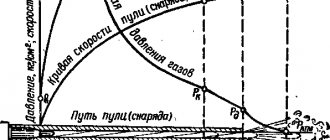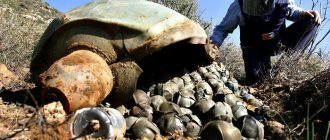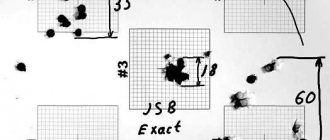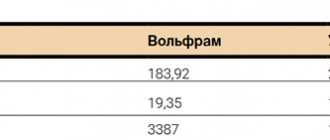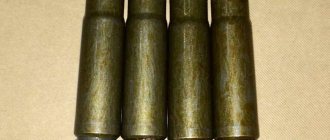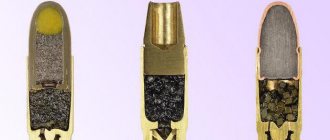The ruthless logic of war in most cases is aimed at inflicting maximum irreparable damage on the enemy. This explains the rapid development of military technologies and the creation of ever new means of mass destruction. Particularly cruel among them are hollow-point bullets, which are currently prohibited for use in military operations.
Against the backdrop of such sophisticated weapons of mass murder as nuclear weapons or multiple launch rocket systems, the history of the expansive bullet is little known and almost forgotten, although with its “help” tens, and maybe hundreds of thousands of people at one time died a painful death or were maimed.
How Expansive Bullets Work
What does an expansive bullet mean? One of the meanings of the Latin word expansus is extensibility. In relation to a bullet, this means that at the moment it hits the target, it sharply increases in diameter, greatly enhancing the damaging effect. When they strike a person, they open up like a flower. This is where their ominous name comes from - “flowers of death”.
A shot from a hollow-point bullet, as a rule, led to death, since when it opened, it increased the focus of tissue damage, while remaining inside the body, while a regular bullet passed right through.
Ammo
Some types of bullets
AP
- Armor Piercing - armor-piercing.
1 — shell (steel, tombac, brass) 2 — lead 3 — carbide armor-piercing core
AFR
— Air Freedom Round — easily destructible (with “controlled ballistics”)
It is destroyed upon impact even on surfaces such as aircraft skins or plywood doors, but has a high stopping effect. Used by special forces to fight terrorists. BT
- Boat Tail - a rifle bullet with a conical tail.
CP
- Cone Point - with a conical head.
EFMJ
- Expanding Full Metal Jacketed
When hitting the body, the bullet should “not come out” of it, and if it misses, it should lose the opportunity to cause any damage. These requirements are met by the so-called. Expansive (expanding) bullets. Such bullets are widely used in police weapons, but are prohibited for use in military weapons. Expansive bullets are conventionally divided into deformable (non-destructible), semi-destructible and collapsible. FMJ
— Full Metal Jacketed — Shell.
1 - shell (steel, tombak, brass) 2 - lead
The most widely used type of ammunition. Practically the only type of bullet adopted by the armies of the world (according to international conventions, expansive ammunition is prohibited for use in military operations).
GSS
- GLASER Safety Slug - easily destructible with controlled ballistics.
1 - bullet nose (metal) 2 - bullet casing (metal) 3 - shot
Consists of the nose part, casing and shot filler. Designed for firing at people not protected by armor in conditions where it is necessary to completely eliminate ricochets and through penetrations (for example, in the cabin of an aircraft).
When the bullet hits the body, it breaks up, forming a conical stream of small (up to 200 particles for a .38 sp bullet) shot, causing very severe wounds. Used by special forces to combat terrorism.
In this case, a significant stopping effect is achieved in combination. Used for self-defense and special forces to fight terrorists.
J.F.P.
— Jacketed Flat Point — Shell with a flat head.
JHP
- Jacketed Hollow Point - Semi-shell with an expansive recess.
1 - jacket (steel, tombac, brass) 2 - lead 3 - expansive notch
A semi-jacketed bullet with an expansive notch (compared to just a semi-jacketed one) has an even greater stopping effect. When it hits a target, such a bullet “opens up,” increasing its cross-sectional area several times.
It practically does not give through wounds and causes severe injuries even when it hits soft tissue. Used as police ammunition and for self-defense.
In some (mainly military) pistols designed for jacketed bullets with an ogive head, problems may arise with chambering such bullets due to the blunt nose of the bullet sticking into the edge of the chamber. Problems are solved by polishing the bevel (ramp) of the chamber.
JSP
— Jacketed Soft Point — Semi-shell.
1 - jacket (steel, tombac, brass) 2 - lead
A semi-jacketed bullet (compared to a jacketed bullet) has a greater stopping effect (the photo shows how the bullet is deformed when it hits the target): less prone to ricochets and less penetrating ability. Used as police ammunition and for self-defense.
J.R.N.
— Jacketed Round Nose — Jacketed with a rounded nose.
Hydrashock
is a semi-shell with an expansive recess and a steel core.
1 - shell (steel, tombak, brass) 2 - lead 3 - expansive recess 4 - steel core
History of appearance
The “homeland” of cartridges with an expansive head is England in the 19th century, mired in numerous colonial wars. The small-caliber shell bullets in service at that time did not cause serious damage to the enemy. As already mentioned, at close range they pierced the body right through.
The development of a new cartridge was entrusted to the British officer Neville Bertie-Clay, who served in the Dum-Dum arsenal near Calcutta. The arsenal's name was later transferred to the infamous bullet. Bertie-Clay apparently knew ballistics and physics well and did not reinvent the wheel. He just sawed off the tip of an ordinary bullet.
However, this simple know-how turned it into a terrible weapon. In addition, now almost any soldier could make expandable ammunition using a simple file, making a cross-shaped cut on them.
For the first time, hollow point bullets were used en masse in the battle of Omdurman (Sudan). According to eyewitnesses, the hit led to extensive abdominal wounds and severe bone damage. The survivors usually became disabled, and therefore the use of hollow point bullets was prohibited by the decision of the 1899 Hague Peace Conference. 8 years later, at the Second Hague Conference, this ban was duplicated.
Two main types of expansion bullets were created: hollow-core and semi-jacketed. A semi-jacketed expansive action is an expansive lead bullet in a copper or brass jacket. Its appearance is associated with the creation of smokeless gunpowder - cordite. At the moment of firing, after an ordinary lead bullet, small fragments remained in the barrel bore, causing the barrel to become unusable over time.
Semi-sheathed expansive bullet
To prevent this from happening, lead bullets began to be placed in a copper or brass shell. At the same time, the expansive effect was retained, but was significantly less compared to ammunition with an expansive cavity.
With the advent of precision-guided ammunition and body armor, the use of hollow-point bullets in conflicts has virtually disappeared. Today, their main area of application is large game hunting. Expansive ammunition is in demand here.
Nine grams of death. The most lethal types of bullets
MOSCOW, December 2 – RIA Novosti, Andrey Stanavov. Complex splinter fractures of bones, ruptures of internal organs and numerous injuries to soft tissues - such terrible consequences can result from a “confrontation” with several grams of lead enclosed in a durable metal shell of a special shape. Over the long history of the development of firearms, hundreds of types of lethal ammunition have been created. The mechanism of action of some is so cruel that they were banned at the very first Hague conference. For example, if a person is seriously wounded by an expansive bullet, there is practically no chance of survival. RIA Novosti talks about some small arms cartridges, the bullets of which cause injuries that are rarely compatible with life.
Modern developments
However, developments continue. So 3 years ago, G2 Research introduced a modern version of an expansive bullet - the 9 mm G2R RIP cartridge with eight small teeth - trocars. According to some experts, this is the “most expansive bullet” today.
As a result of a shot from an expansive G2R RIP bullet, the trocars, like a ring saw, bite into oncoming obstacles, clearing the way to the target for the main damaging element - the bottom part. Plus, the trocar teeth create a turbulent flow, which stabilizes the flight of the bullet and ensures more accurate hitting of the target.
Death Roll
At first glance, a large-caliber bullet may seem more dangerous and destructive than a small-caliber bullet. But that's not true. In pursuit of combat effectiveness, designers of small arms ammunition were able to prove that caliber is no longer so important to inflict maximum damage to manpower. The high initial velocity, slightly elongated pointed shape and slight shift of the center of mass towards the tail can turn even a small 5.45 mm bullet into a terrible “meat grinder” for those for whom it was intended. In addition, a light bullet manages to transfer more kinetic energy to an object than a heavy one; these are already the laws of physics.
As a rule, upon collision with a target, the longitudinal axis of the “unbalanced” mini-projectile deviates from the flight path, and it begins to tumble randomly, tearing soft tissue and destroying bones at great speed. Instead of a narrow through one, a wide curved wound channel is formed in the body with extensive peripheral damage, often leading to death.
In particular, the domestic low-pulse 5.45x39 caliber cartridge, developed for the Kalashnikov assault rifle and put into service in 1974, is equipped with such a deadly bullet. It has an air cavity in the nose, due to which the center of mass is shifted back. This ammunition was a response to the armies of NATO countries, armed with a 5.56x45 cartridge with a bullet that unfolds and breaks in the body of the victim. It is interesting that a through wound from a heavier bullet from the Soviet 7.62x39 cartridge is less dangerous for a person, unless, of course, bones and vital organs are hit. It does not tumble, but simply stitches through soft tissue. It is much easier to heal such a wound.
What can be contrasted
It is worth remembering the “close relatives” of expansive projectiles - bullets with a shifted center of gravity, one of the varieties of pointed bullets that replaced the outdated blunt-pointed ones at the beginning of the 20th century. The new ammunition had improved aerodynamics, lighter weight and a higher muzzle velocity.
The shifted center of gravity led to the fact that at the moment it hit the body, the bullet did not flatten, but began to “tumble” chaotically. In this case, the exit hole could form in the most unexpected place. It is not difficult to imagine that the wound from such a bullet was no less severe than from a hollow-point bullet.
The US Army widely used the M-193 offset bullet in the M-16 rifle during the Vietnam War. Our answer was the 5.45 x 39 (7N6) cartridge for the Ak-74 assault rifle, which was tested in Afghanistan.
Ammo
Some types of bullets
AP
- Armor Piercing - armor-piercing.
1 — shell (steel, tombac, brass) 2 — lead 3 — carbide armor-piercing core
AFR
— Air Freedom Round — easily destructible (with “controlled ballistics”)
It is destroyed upon impact even on surfaces such as aircraft skins or plywood doors, but has a high stopping effect. Used by special forces to fight terrorists. BT
- Boat Tail - a rifle bullet with a conical tail.
CP
- Cone Point - with a conical head.
EFMJ
- Expanding Full Metal Jacketed
When hitting the body, the bullet should “not come out” of it, and if it misses, it should lose the opportunity to cause any damage. These requirements are met by the so-called. Expansive (expanding) bullets. Such bullets are widely used in police weapons, but are prohibited for use in military weapons. Expansive bullets are conventionally divided into deformable (non-destructible), semi-destructible and collapsible. FMJ
— Full Metal Jacketed — Shell.
1 - shell (steel, tombak, brass) 2 - lead
The most widely used type of ammunition. Practically the only type of bullet adopted by the armies of the world (according to international conventions, expansive ammunition is prohibited for use in military operations).
GSS
- GLASER Safety Slug - easily destructible with controlled ballistics.
1 - bullet nose (metal) 2 - bullet casing (metal) 3 - shot
Consists of the nose part, casing and shot filler. Designed for firing at people not protected by armor in conditions where it is necessary to completely eliminate ricochets and through penetrations (for example, in the cabin of an aircraft).
When the bullet hits the body, it breaks up, forming a conical stream of small (up to 200 particles for a .38 sp bullet) shot, causing very severe wounds. Used by special forces to combat terrorism.
In this case, a significant stopping effect is achieved in combination. Used for self-defense and special forces to fight terrorists.
J.F.P.
— Jacketed Flat Point — Shell with a flat head.
JHP
- Jacketed Hollow Point - Semi-shell with an expansive recess.
1 - jacket (steel, tombac, brass) 2 - lead 3 - expansive notch
A semi-jacketed bullet with an expansive notch (compared to just a semi-jacketed one) has an even greater stopping effect. When it hits a target, such a bullet “opens up,” increasing its cross-sectional area several times.
It practically does not give through wounds and causes severe injuries even when it hits soft tissue. Used as police ammunition and for self-defense.
In some (mainly military) pistols designed for jacketed bullets with an ogive head, problems may arise with chambering such bullets due to the blunt nose of the bullet sticking into the edge of the chamber. Problems are solved by polishing the bevel (ramp) of the chamber.
JSP
— Jacketed Soft Point — Semi-shell.
1 - jacket (steel, tombac, brass) 2 - lead
A semi-jacketed bullet (compared to a jacketed bullet) has a greater stopping effect (the photo shows how the bullet is deformed when it hits the target): less prone to ricochets and less penetrating ability. Used as police ammunition and for self-defense.
J.R.N.
— Jacketed Round Nose — Jacketed with a rounded nose.
Hydrashock
is a semi-shell with an expansive recess and a steel core.
1 - shell (steel, tombak, brass) 2 - lead 3 - expansive recess 4 - steel core
A combination of semi-shell expansive and armor-piercing bullets with all their advantages and disadvantages.
L
— Lead — All-lead.
LHP
- Lead Hollow Point - Shellless with an expansive notch.
LRN
- Lead Round Nose - Shellless, rounded.
The earliest and cheapest type.
Currently used little, mainly for sport target shooting (caliber 5.6 mm, also known as .22LR). In case of damage to manpower, it has an increased stopping effect due to deformation upon impact. Virtually no ricochets.
